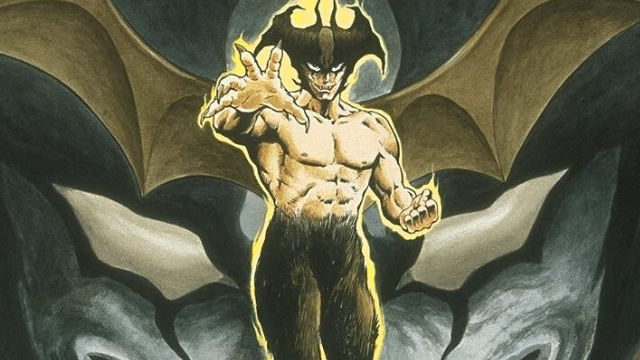
I've always had a thing for villains. Unlike my brothers, as a kid I'd always choose the "bad guy" action figures. If they went for the ninja turtle Leonardo, then I'd go for the uber-buff Super Shredder. I personally identified with villainy because of how it connected to the idea of "evil." I personally see evil as a generalized concept that expresses antagonism toward violent and dominant societal structures. Due to a coercive religious upbringing, I now see how my younger self unconsciously found ideologically-oppositional comfort in "evil" art. This eventually led me to one of my most cherished pieces of fiction: Devilman.
Devilman has left an indelible mark on manga and anime creators over the last few decades, inspiring major industry heavyweights such as Hideaki Anno, Kentaro Miura, and Kazuki Nakashima. The series was created by Go Nagai, a manga auteur also responsible for Mazinger Z, Cutie Honey, and Violence Jack (which is a Devilman sequel). Although Devilman retains much of the explicitness native to Go Nagai's usual fare, it uses these graphic elements uniquely to deliver a haunting, unforgettable, and compassionate message.
Let's explore the surprisingly relevant political and social significance of Devilman, along with a few of its animated offshoots. Read on but be forewarned, this article contains major spoilers!
Devilman (original manga, 1972)
The Devilman manga is a dark antiwar narrative in deep contrast to the standard monster-of-the-day, "evil fights evil" set-up of the anime (which ran at the same time as the manga). Ryo Asuka — who turns out to be Satan, the leader of all demons — helps convince the world that anyone dissatisfied with the status quo could turn into a demon and needs to be killed. Every nation starts a war with each other, and Japan creates the "Demon Busters" to murder anyone suspected of being a demon. This plot twist is the most explicitly political angle in Devilman and a clear critique against the genocide of marginalized peoples. One page features a taste of the global hate brewing around the world: a collective white desire to murder Black communities, the renewal of German anti-Semitism, and hatred for any protestor. There are also many moments that display the horrors of historical genocide when Akira and Ryo travel through time.
Devilman builds additional nuance around this theme with Ryo's character. In the manga's final scene, Ryo describes how demons were once oppressed by God, and that they in turn preyed upon humans in the same way that God preyed upon demons. Ryo recognizes that he continued the same cycle of genocidal hate and marginalization he once suffered. This is a striking moment that functions as a cautionary warning against abusing imbalanced power dynamics, and how even once marginalized groups are still capable of enacting horrors against those with less power.
Ryo's character also made a groundbreaking stride in the representation of marginalized gender and sexual identities. His true form as Satan is easy to interpret as trans, possessing emotional, mental, and physical traits that defy the standard gender binary. The manga also makes it clear that Ryo considers Akira more than a friend, and is actually in love with him. Amazingly, Go Nagai does not use Ryo's trans-coded self or his queer love for Akira as fodder for insulting or disrespectful commentary from other characters. Ryo's gender-variant form is certainly mentioned, but it's never negatively framed or conflated with his murderous attitude toward humanity. Additionally, the manga never suggests Ryo is evil because of his romantic feelings for Akira (a simple, yet important distinction). It feels all the more impressive when you remember that this was made in 1972. Devilman's subversive portrayal of non-normative gender and sexual identity could still be considered groundbreaking even by today's standards.
Devilman OVAs
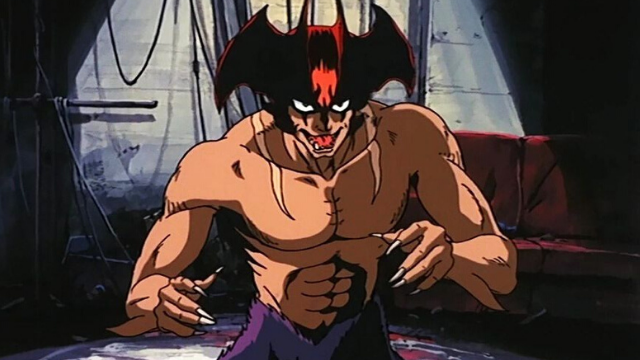
The first OVA, The Birth, covers Ryo and Akira's discovery of demon existence, with a very brutal early sequence that shows the bloody survival-of-the-fittest origins of life on Earth (which beautifully expands upon and mirrors the same sequence from the manga). It concludes with a gore-soaked finale where we see Akira's fateful transformation into Devilman. The sequence is filled with face stabs, top-notch body horror, and decapitations galore as Devilman rips apart demon after demon in a nightclub setting.
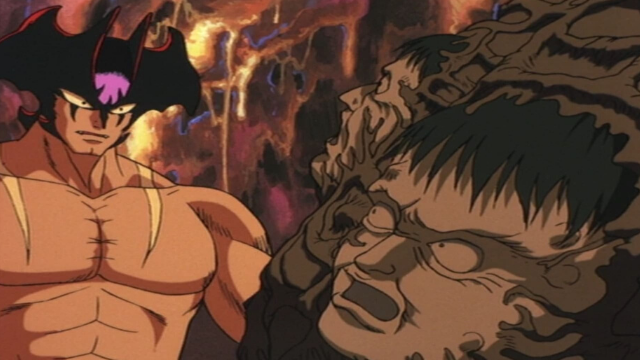
The second OVA, The Demon Bird, had the same crew that worked on the first OVA and contains a very similar feel. This OVA is more action-oriented than the first since it doesn't spend time on the build-up and exposition leading to Devilman's initial appearance. The animation and art design is probably even better than the first episode, which is most notable during the fight with Sirene. On a side note, the Manga Entertainment dubs for these first two OVAs are absolutely essential if you're seeking a fun evening with fellow anime nerds with a decent sense of humor. Their typically sleazy dubs — where Manga Entertainment excessively hyped up the seedier, more "adult" side of anime in order to market their products as wildly different from cartoons for kids — contain an assortment of unnecessary profanity and generally crude dialogue compared to the Japanese source material, to great comedic effect.
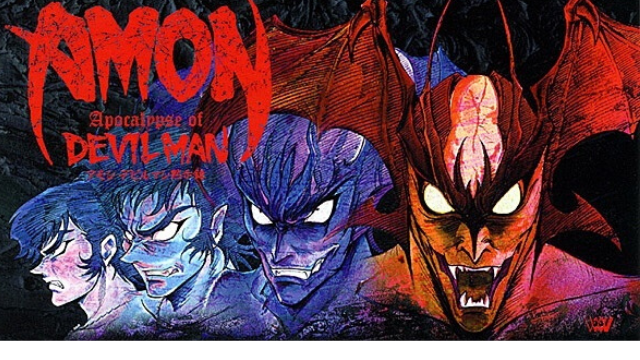 The third OVA, Amon: The Apocalypse of Devilman, is based on Amon: The Darkside of Devilman manga, an alternate-universe offshoot by Yu Kinutani. This OVA contains a reworked version of the end of Devilman and has a much darker edge compared to the first two OVAs. This entry in the series has an ugly, grim quality to it – such as the horrific depiction of Miki and her brother getting slaughtered by an angry mob — that initially felt off-putting to me. I started to enjoy it more on subsequent viewings however, when I remembered that, well, the entire Devilman mythos is pretty damned bleak in general. I think the desolate mood would have been more bearable had Akira felt like the compassionate, tragic hero of the manga.
The third OVA, Amon: The Apocalypse of Devilman, is based on Amon: The Darkside of Devilman manga, an alternate-universe offshoot by Yu Kinutani. This OVA contains a reworked version of the end of Devilman and has a much darker edge compared to the first two OVAs. This entry in the series has an ugly, grim quality to it – such as the horrific depiction of Miki and her brother getting slaughtered by an angry mob — that initially felt off-putting to me. I started to enjoy it more on subsequent viewings however, when I remembered that, well, the entire Devilman mythos is pretty damned bleak in general. I think the desolate mood would have been more bearable had Akira felt like the compassionate, tragic hero of the manga.
Actually, overall I'd say that Akira's portrayal is one of my biggest complaints about these OVAs. He displays a cold lack of care for human life — like in the Demon Bird when he unconcernedly tears through an airplane while fighting Sirene and allows its passengers to presumably plummet to their deaths — that for me, offsets one of the biggest strengths of Devilman's core: that although Akira has the body of a demon, he never loses the tender heart of a human. With that in mind, let's explore Devilman Crybaby.
Devilman Crybaby
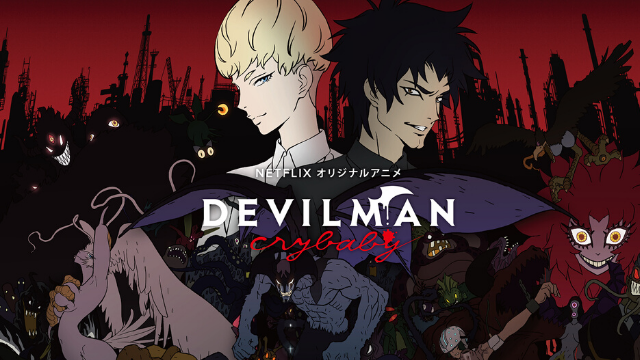
Devilman Crybaby is my favorite animated incarnation of Devilman, period. I might be in the minority with that opinion, but I think there's a lot to love. Masaaki Yuasa is already one of my favorite recent anime directors — Kaiba, Mind Game, and Lu Over the Wall are highlights — so it's no surprise I'd be head over heels for his take on a classic Go Nagai story.
Yuasa impressively shifts the '70s setting of the original into modern-day Japan: The group of surly highschoolers from the manga are replaced with rappers and smartphones are everywhere. In the hands of a lesser writer, a modern setting would be no more than a cosmetic, surface-level change of scenery to an already-written narrative. In contrast, Yuasa avoids this trap by using the modern setting to make incisive social commentary relevant to our times: social media is the means for both horrendous and beautiful moments in the show. It leads to Miki's murder when she posts on Instagram to defend Akira, but also serves as the online catalyst that unites Devilmen across the globe (in contrast to the original manga, where a set of demon-possessed psychic monks unite the Devilmen). Yuasa explained this in a 2018 Japan Times article:
"Today's situation is a lot closer to 'Devilman' than it was when Nagai wrote it in the '70s," he says. "The popularity of social media means people are a lot more connected, for good and bad – like someone getting shot over a video game. We learn about unarmed black people being killed by police, people being tortured and the rise of nationalism in politics. In Japan, too, where a lot of problems are openly blamed on foreigners.
"But it can also help spread good that we wouldn't otherwise know about. We see people coming out as gay or trans on social media, and there's a greater opening up and acceptance of different opinions and lifestyles."

Another beautiful aspect of the show is how Yuasa amplifies the queer elements present in the manga. Ryo and Akira's relationship feels even more loaded with romantic undertones, and Yuasa also introduces two queer characters unseen in the original manga. One of the characters is named Miki Kuroda, initially portrayed as a jealous antagonistic foil to the Miki we all know and love. Miki Kuroda changes as the episodes progress and she becomes a Devilman, and we eventually see her sacrifice herself in an attempt to save Miki Makimura, who she confesses her love to before dying. It's refreshing to see a queer woman represented in a story that previously had none, and incorporated in a way that feels organic and thoughtfully integrated within the larger narrative.
In contrast to the Akira of the OVAs, I absolutely adore this incarnation. Yuasa did a stellar job showing not only Akira's horny goth-jock side but also his compassionate traits. As the name implies, there's a lot of crying in Devilman Crybaby, and Akira is responsible for at least half the tears throughout the brief 10-episode series. Akira evokes such intense compassion and cares for people around him, which is a noticeable deviation from his cold demeanor in the OVAs. The human heart at the core of Devilman is on full display here, taking the emotional elements from the original and turning the volume up to 11. Though the art style and setting might be drastically different from what you'd typically expect of a Devilman remake, Yuasa did a masterful job honoring the source material while injecting it with fresh life and even fresher modern resonance.
What other aspects of Devilman — or its many incarnations — did you find important or interesting? Let me know in the comments below!
Do you love anime? Do you love writing? If you have an idea for a features story, pitch it to Crunchyroll Features!
Source: Latest in Anime News by Crunchyroll!


Comments
Post a Comment